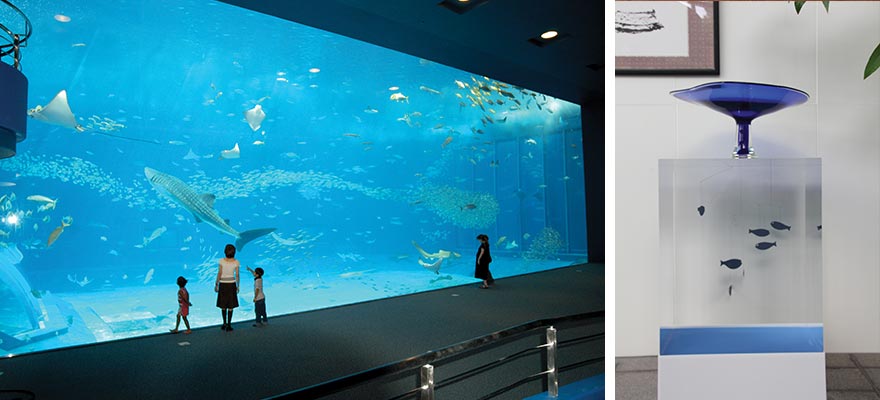Home > Highlighting JAPAN >Highlighting Japan July 2014>Summer in Japan
Highlighting JAPAN
Summer in Japan
Perfectly Clear
Nippura's Founder Shapes Our Views of the World's Aquariums

Nearly half a century ago Tetsuhiro Shikiyama, who's a chemist by trade, made what could only be called art, in the form of handsome lampshades and decorative plates crafted from thin strips of laminated wood. While it's unlikely that many are familiar with those works, millions have seen his other creations made in the decades since. In fact, they've looked right through them, probably too busy staring at the sharks, jellyfish, penguins and other sea creatures within to be aware of their existence. Shikiyama is the president of Nippura, a company he founded in 1969 that makes acrylic glass panels for water tanks in aquariums around the globe, including the Monterey Bay Aquarium, Copenhagen Zoo, New England Aquarium and Okinawa Churaumi Aquarium.
A lean company of fewer than ninety employees with its headquarters in southwestern Kagawa Prefecture, Nippura in many ways exemplifies Japan's tradition of combining advanced technology, design and careful craftsmanship to make products the world demands. Shikiyama himself is 81 years old and has the energy and dynamism of a man decades younger.
"My company was the first in the world to use big acrylic glass panels for aquarium tanks," he says. Before Nippura took a chance with a curved acrylic glass panel at Yashima Aquarium in Kagawa, tanks in aquariums were built with rigid glass that precluded big sizes and fancy curves. Since that early feat in 1969, the company has developed stronger and more transparent panels that have held Guinness World Records because of their size. One tank created for the Dubai Mall in the United Arab Emirates, for example, held the title in 2008 at 32.88 meters long and 8.3 meters tall.
Sitting at a conference room table at Nippura's headquarters, Shikiyama explains the company's technology. He pushes forward a cube about 25 centimeters tall. Despite its thickness, the object is perfectly clear when viewed head on. It's like looking through still water.
Then he turns the cube to the side to show that it isn't solid. Instead, there are six layers of acrylic glass, each about three centimeters thick.
Nippura believes that increasing the thickness by stacking plates of from three to four centimeters thick and then heat-treating the result offers the most stable quality. This layering and bonding technique—along with the company's chemical compound formulas and strict attention to detail—are what make Nippura's panels clearer, stronger and more durable, says Shikiyama.
His customers agree. New England Aquarium in Boston came to Nippura in the early 2000s when it needed a super-stretch kreisel tank for jellyfish, after hearing about the company's earlier success with the Monterey Bay Aquarium, says Steven L. Bailey, New England Aquarium's curator of fishes. Bailey called Nippura's work "outstanding," and praised "the way they work for being top-notch at following precise instructions, having knowledge of larger-scale kreisel tanks, and having a record of delivering on an expensive undertaking on time."
Nippura is now exploring new ways to use the acrylic glass that Shikiyama has been experimenting with since he studied chemistry at Nishiwaki Kogyo technical school, even after all his successes. Nippura also began using the panels to make large, flat projection screens about ten years ago. Applying the same processing techniques to acrylic panels used for creating water tanks has made it possible to make the screens flat as well as various unprecedented shapes. Shikiyama says he believes the potential also exists to use the panels for clear, thin barriers to protect against tsunami waves. That urge to tinker is what keeps him going to work.
"I don't even take a day off," he says, and adds with a smile: "I'm here 365 days a year."
In terms of energy and his unending dedication to the art of invention, Shikiyama is clearly one of Japan's master innovators.
© 2009 Cabinet Office, Government of Japan






